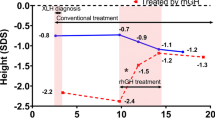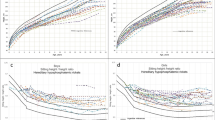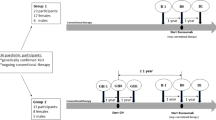Abstract
Background
We recently showed that a 3-year growth hormone (GH) treatment improves linear growth in severely short children with X-linked hypophosphatemic rickets (XLH). It is unknown if GH therapy increases adult height in XLH patients.
Methods
We carried out a follow-up analysis of a randomized controlled open-label GH study in short prepubertal children with XLH on phosphate and active vitamin D treatment. The changes in SD scores (SDS) of height, sitting height, leg and arm length, and sitting height index (i.e., the ratio between sitting height and height) were analyzed in 11 out of 16 patients followed-up until adult height.
Results
At baseline, XLH patients showed disproportionately short stature with reduced standardized height (−3.2 ± 0.6), sitting height (−1.7 ± 0.6), leg (−3.7 ± 0.7) and arm (−2.5 ± 0.8) length, and markedly elevated sitting height index (3.3 ± 0.6; each p < 0.01 versus healthy children). In GH-treated patients, adult height, sitting height, leg length, and arm length exceeded baseline values by 0.7 SDS, 1.7 SDS, 0.7 SDS, and 1.2 SDS respectively, although this was only significant for sitting height. In controls, no significant changes in linear body dimensions were noted. Adult height did not statistically differ between groups (−2.4 ± 0.7 vs −3.3 ± 1.2, p = 0.082). GH did not exaggerate body disproportion.
Conclusions
Growth hormone treatment did not significantly increase adult height in this group of short children with XLH, which may be at least partly due to the small number of patients included in our study.


Similar content being viewed by others
References
Yamazaki Y, Okazaki R, Shibata M, Hasegawa Y, Satoh K, Tajima T, Takeuchi Y, Fujita T, Nakahara K, Yamashita T, Fukumoto S (2002) Increased circulatory level of biologically active full-length FGF-23 in patients with hypophosphatemic rickets/osteomalacia. J Clin Endocrinol Metab 87(11):4957–4960
Jonsson KB, Zahradnik R, Larsson T, White KE, Sugimoto T, Imanishi Y, Yamamoto T, Hampson G, Koshiyama H, Ljunggren O, Oba K, Yang IM, Miyauchi A, Econs MJ, Lavigne J, Juppner H (2003) Fibroblast growth factor 23 in oncogenic osteomalacia and X-linked hypophosphatemia. N Engl J Med 348(17):1656–1663
Goetz R, Nakada Y, MC H, Kurosu H, Wang L, Nakatani T, Shi M, Eliseenkova AV, Razzaque MS, Moe OW, Kuro-o M, Mohammadi M (2010) Isolated C-terminal tail of FGF23 alleviates hypophosphatemia by inhibiting FGF23-FGFR-klotho complex formation. Proc Natl Acad Sci U S A 107(1):407–412
Liu S, Tang W, Zhou J, Stubbs JR, Luo Q, Pi M, Quarles LD (2006) Fibroblast growth factor 23 is a counter-regulatory phosphaturic hormone for vitamin D. J Am Soc Nephrol 17(5):1305–1315
Carpenter TO, Imel EA, Holm IA, Jan de Beur SM, Insogna KL (2011) A clinician’s guide to X-linked hypophosphatemia. J Bone Miner Res 26(7):1381–1388
Pavone V, Testa G, Gioitta Iachino S, Evola FR, Avondo S, Sessa G (2015) Hypophosphatemic rickets: etiology, clinical features and treatment. Eur J Orthop Surg Traumatol 25(2):221–226
Zivicnjak M, Schnabel D, Billing H, Staude H, Filler G, Querfeld U, Schumacher M, Pyper A, Schroder C, Bramswig J, Haffner D (2011) Age-related stature and linear body segments in children with X-linked hypophosphatemic rickets. Pediatr Nephrol 26(2):2232–2231
Kruse K, Hinkel GK, Griefahn B (1998) B calcium metabolism and growth during early treatment of children with X-linked hypophosphataemic rickets. Eur J Pediatr 157(11):894–900
Makitie O, Doria A, Kooh SW, Cole WG, Daneman A, Sochett E (2003) Early treatment improves growth and biochemical and radiographic outcome in X-linked hypophosphatemic rickets. J Clin Endocrinol Metab 88(8):3591–3597
Quinlan C, Guegan K, Offiah A, Neill RO, Hiorns MP, Ellard S, Bockenhauer D, Hoff WV, Waters AM (2012) Growth in PHEX-associated X-linked hypophosphatemic rickets: the importance of early treatment. Pediatr Nephrol 27(4):581–588
Santos F, Fuente R, Mejia N, Mantecon L, Gil-Pena H, Ordonez FA (2013) Hypophosphatemia and growth. Pediatr Nephrol 28(4):595–603
Ariceta G, Langman CB (2006) Growth in X-linked hypophosphatemic rickets. Eur J Pediatr 166(4):303–309
Linglart A, Biosse-Duplan M, Briot K, Chaussain C, Esterle L, Guillaume-Czitrom S, Kamenicky P, Nevoux J, Prie D, Rothenbuhler A, Wicart P, Harvengt P (2014) Therapeutic management of hypophosphatemic rickets from infancy to adulthood. Endocr Connect 3(1):R13–R30
Carpenter TO, Insogna KL, Zhang JH, Ellis B, Nieman S, Simpson C, Olear E, Gundberg CM (2010) Circulating levels of soluble klotho and FGF23 in X-linked hypophosphatemia: circadian variance, effects of treatment, and relationship to parathyroid status. J Clin Endocrinol Metab 95(11):E352–E357
Lanes R, Harrison HE (1990) Growth hormone therapy in a poorly growing child with hypophosphatemic rickets. J Endocrinol Investig 13(10):833–837
Wilson DM, Lee PD, Morris AH, Reiter EO, Gertner JM, Marcus R, Quarmby VE, Rosenfeld RG (1991) Growth hormone therapy in hypophosphatemic rickets. Am J Dis Child 145(10):1165–1170
Saggese G, Baroncelli GI, Bertelloni S, Perri G (1995) Long-term growth hormone treatment in children with renal hypophosphatemic rickets: effects on growth, mineral metabolism, and bone density. J Pediatr 127(3):395–402
Haffner D, Wuhl E, Blum WF, Schaefer F, Mehls O (1995) Disproportionate growth following long-term growth hormone treatment in short children with X-linked hypophosphataemia. Eur J Pediatr 1154(8):610–613
Reusz GS, Miltenyi G, Stubnya G, Szabo A, Horvath C, Byrd DJ, Peter F, Tulassay T (1997) X-linked hypophosphatemia: effects of treatment with recombinant human growth hormone. Pediatr Nephrol 11(5):573–577
Seikaly MG, Brown R, Baum M (1997) The effect of recombinant human growth hormone in children with X-linked hypophosphatemia. Pediatrics 100(5):879–884
Zivicnjak M, Schnabel D, Staude H, Even G, Marx M, Beetz R, Holder M, Billing H, Fischer DC, Rabl W, Schumacher M, Hiort O, Haffner D (2011) Three-year growth hormone treatment in short children with X-linked hypophosphatemic rickets: effects on linear growth and body disproportion. J Clin Metab 96(12):2097–2105
Baroncelli GI, Bertelloni S, Ceccarelli C, Saggese G (2001) Effect of growth hormone treatment on final height, phosphate metabolism, and bone mineral density in children with X-linked hypophosphatemic rickets. J Pediatr 138(2):236–243
Haffner D, Nissel R, Wuhl E, Mehls O (2004) Effects of growth hormone treatment on body proportions and final height among small children with X-linked hypophosphatemic rickets. Pediatrics 113(6):E593–E596
Hoyer PF (2004) Nephrokalzinose. In: Hofmann V, Deeg KH, Hoyer PF (eds) Ultraschall-diagnostik in Pädiatrie und Kinderchirurgie. Thieme, Stuttgart, pp 467–470
Greulich WW, Pyle SI (1959) Radiographic atlas of skeletal development of the hand and wrist. Stanford University Press, Stanford
Brodehl J, Krause A, Hoyer PF (1988) Assessment of maximal tubular phosphate reabsorption: comparison of direct measurement with the nomogram of Bijvoet. Pediatr Nephrol 2(2):183–189
De Souza VC, Rabilloud M, Cochat P, Selistre L, Hadj-Aissa A, Kassai B, Ranchin B, Berg U, Herthelius M, Dubourg L (2012) Schwartz formula: is one k-coefficient adequate for all children? PLoS One 7(12):E53439
Weiner JS, Lourie JA (1981) Practical human biology. Academic Press, London
Zivicnjak M, Narancic NS, Szirovicza L, Franke D, Hrenovic J, Bisof V (2003) Gender-specific growth patterns for stature, sitting height and limbs length in Croatian children and youth (3 to 18 years of age). Coll Antropol 27(1):321–334
Zivicnjak M, Franke D, Filler G, Haffner D, Froede K, Nissel R, Haase S, Offner G, Ehrich JH, Querfeld U (2007) Growth impairment shows an age-dependent pattern in boys with chronic kidney disease. Pediatr Nephrol 22(3):420–429
Zivicnjak M, Smolej Narancic N, Szirovicza L, Franke D, Hrenovic J, Bisof V, Tomas Z, Skaric-Juric T (2008) Gender-specific growth patterns of transversal body dimensions in Croatian children and youth (2 to 18 years of age). Coll Antropol 32(2):419–431
Molinari L, Largo RH, Prader A (1985) Target height and secular trend in the Swiss population. In: Borms J, Hauspie R, Sand A, Susanne C, Habbelinck M (eds) Human growth and development. Plenum, New York, pp 193–200
Bayley N, Pinneau S (1952) Tables for predicting adult height from skeletal age: revised for use with the Greulich-Pyle hand standards. J Pediatr 40(4):423–441
Nielsen LH, Rahbek ET, Beck-Nielsen SS, Christesen HT (2014) Treatment of hypophosphataemic rickets in children remains a challenge. Dan Med J 61(7):A4874
Imel EA, DiMeglio LA, Hui SL, Carpenter TO, Econs MJ (2010) Treatment of X-linked hypophosphatemia with calcitriol and phosphate increases circulating fibroblast growth factor 23 concentrations. J Clin Endocrinol Metab 95(4):1846–1850
Efthymiadou A, Kritikou D, Mantagos S, Chrysis D (2016) The effect of GH treatment on serum FGF23 and klotho in GH-deficient children. Eur J Endocrinol 174(4):473–479
Auron A, Alon US (2005) Resolution of medullary nephrocalcinosis in children with metabolic bone disorders. Pediatr Nephrol 20(8):1143–1145
Allen DB (2011) Safety of growth hormone treatment of children with idiopathic short stature: the US experience. Horm Res Paediatr 76 [Suppl 3]:45–47
Wolfgram PM, Carrel AL, Allen DB (2013) Long-term effects of recombinant human growth hormone therapy in children with Prader-Willi syndrome. Curr Opin Pediatr 25(4):509–514
Ricotti S, Petrucci L, Carenzio G, Klersy C, Calcaterra V, Larizza D, Dalla Toffola E (2011) Prevalence and incidence of scoliosis in Turner syndrome: a study in 49 girls followed-up for 4 years. Eur J Phys Rehabil Med 47(3):447–453
Acknowledgements
We very much appreciate the willingness of our patients and their families to participate in this trial. We thank all the members of the Hypophosphatemic Rickets Study Group of the “Deutsche Gesellschaft für Kinderendokrinologie und -diabetologie” (German Society for Pediatric Endocrinology and Diabetology) and the “Gesellschaft für Pädiatrische Nephrologie” (German Society for Pediatric Nephrology) for their help in the design and realization of this project. We especially thank E. Schmid (Kinderpraxen Hirschaid, Germany) and D. Wölfel (Children’s Hospital Göppingen, Germany, who recruited patients into this study. This project was supported by a research grant from Pfizer Pharma GmbH, who also provided Genotropin™ for treatment.
Author information
Authors and Affiliations
Consortia
Corresponding author
Ethics declarations
The study received full approval from the Ethics Committee of the Charité Hospital, Berlin and each participating center. Assent and written informed consent for participation was obtained from all patients and/or their parents.
Conflicts of interest
DH has served as a consultant for Sandoz and has received honoraria and/or research support from Amgen Inc., Horizon Pharma, Kyowa Kirin, Merck Serono, Pfizer, and Sandoz. DS has served as a consultant for Sandoz and Novo Nordisk and has received honoraria from Kyowa Kirin, Alexion, Merck Serono, Pfizer, and Ipsen. OH has served as a consultant for Novo Nordisk and has received honoraria from Sandoz, Ipsen, Merck Serono, and Ultragenyx. MŽ, NM, HS, EW, MM, RB, UQ, MH, HB, WR, CS, JB, and AR declare that they have no conflicts of interest to declare.
Rights and permissions
About this article
Cite this article
Meyerhoff, N., Haffner, D., Staude, H. et al. Effects of growth hormone treatment on adult height in severely short children with X-linked hypophosphatemic rickets. Pediatr Nephrol 33, 447–456 (2018). https://doi.org/10.1007/s00467-017-3820-3
Received:
Revised:
Accepted:
Published:
Issue Date:
DOI: https://doi.org/10.1007/s00467-017-3820-3




